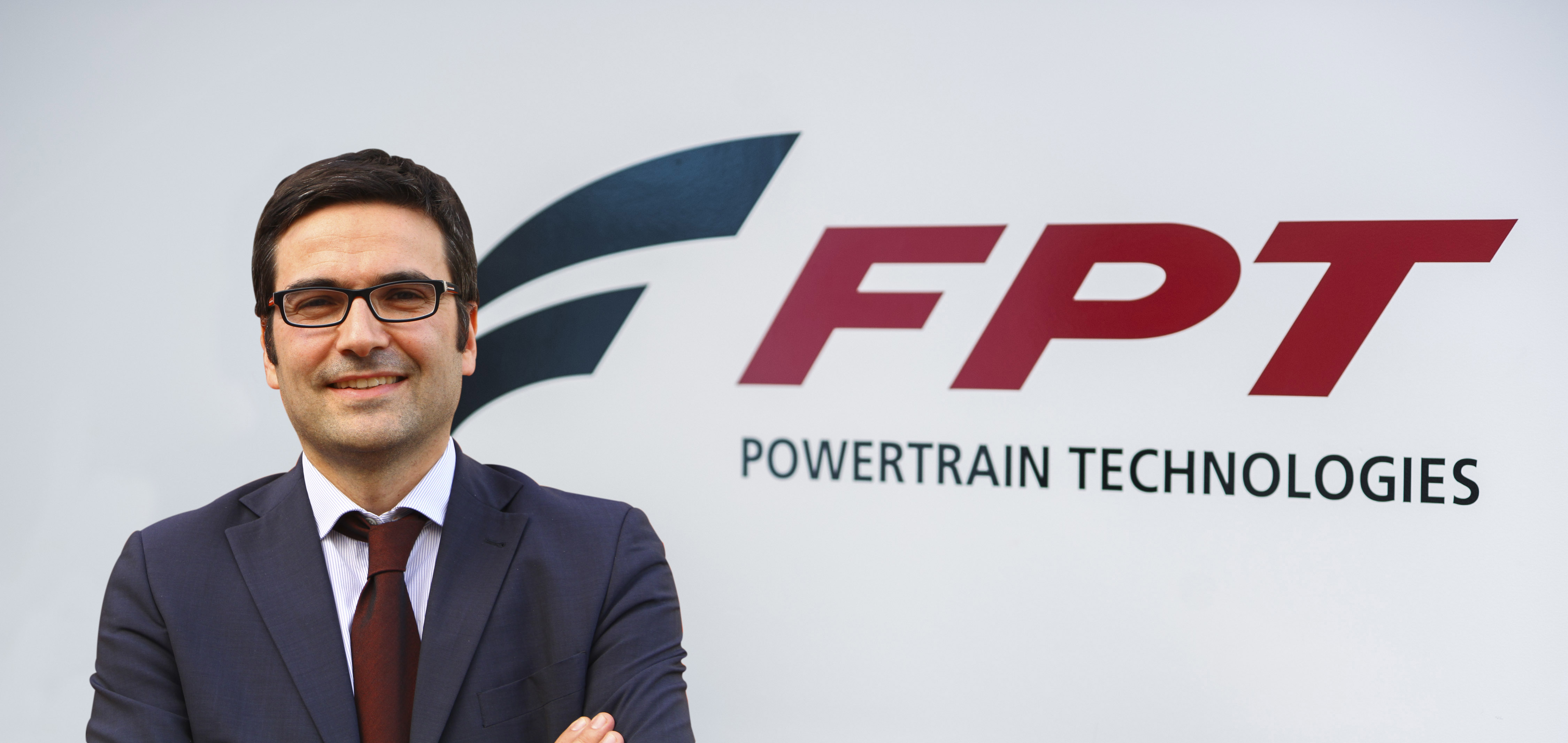 Federico Gaiazzi表示,目前菲亚特动力科技发动机系列的制动热效率达到了46%左右。图中显示的是FPT的C13二阶式发动机。
Federico Gaiazzi表示,目前菲亚特动力科技发动机系列的制动热效率达到了46%左右。图中显示的是FPT的C13二阶式发动机。 菲亚特动力科技市场与产品管理副总裁Federico Gaiazzi指出,提高发动机的制动热效率非常重要。他预测,FPT将于2020年前将工业发动机的制动热效率提升至55%。
菲亚特动力科技市场与产品管理副总裁Federico Gaiazzi指出,提高发动机的制动热效率非常重要。他预测,FPT将于2020年前将工业发动机的制动热效率提升至55%。
预计在2019年,欧洲五阶段(Stage V)非公路发动机排放法规将成为菲亚特动力科技(以下简称FPT)的头等大事。届时,欧盟法规将严格限定排放物的颗粒物浓度(PN),颗粒物质量限值要求也将收紧。五阶段法规同样也会降低氮氧化物、碳氢化合物和一氧化氮的限值。
菲亚特动力科技的市场与产品管理副总裁Federico Gaiazzi认为,尽管五阶段法规要求很严苛,但其控制的欧盟市场毕竟只是全球市场中的一小部分。 在Gaiazzi与《SAE非公路工程》的访谈中,他指出欧盟法规很可能对世界其他地区的法规制定者造成影响,使其在考虑自己国家需求的时候调整策略。Gaiazzi相信,为了配合欧盟,其他国家的排放法规与燃油质量规定也将更加严格。
这意味着FPT需要对其全球市场的发动机进行升级,并使用与欧盟市场相似的高级技术。“在朝着未来的排放标准努力的同时,FPT也在考虑研发新的方案,以提升发动机效率并降低总拥有成本,这也是为什么我们坚持只使用‘长期高效选择性催化还原(HI-eSCR)’技术策略的原因。” Gaiazzi表示,这一技术替换了中型和重型车辆中的废气再循环(EGR)技术,既简化了发动机,也降低了成本。
Gaiazzi预测,FPT的下一代HI-eSCR后处理方案是在SCR上添加一个柴油颗粒过滤器(DPF)。一部分SCR催化剂的作用将由这个过滤器代替,以避免对整个后处理系统的布局造成影响。据称,这一技术在颗粒质量和PN排放方面都能满足要求。总的来看,这个将两种技术进行结合的系统不仅可以缩小发动机体积,还能更方便地管理SCR所需的温度。(详情请阅读《非公路发动机的复杂未来》,SOHE,2015年8月刊)
“HI-eSCR系统原本是位于瑞士亚邦的FPT研发中心开发的。它是第一个无需保养的后处理系统,而且可以减少95%以上的氮氧化物含量,” Gaiazzi表示。行业中的其他人士也指出新的SCR技术可以在降低97-98%的氮氧化物,而这也正是其能够淘汰EGR的关键能力。
当被问及哪些高级技术对提高燃油效率和降低运作成本最为重要时,Gaiazzi提供了一个视角宽广的答案。
“没有哪一个单独的技术领域可以在降低燃耗或提高发动机性能上起到突破性的作用,”他表示。最关键的方法就是提高发动机的制动热效率。“这是一道难题,这是无法通过某项技术突破一蹴而就的;相反,只有通过发动机各个部分的共同改进,才能积累优势,最终形成进步。”
这些改进中包括燃烧和空气处理手段的优化、能量损失抑制、智能辅助系统、排气管道废热回收,以及发动机与相关系统中的能量管理等技术,此外还包括整辆汽车中影响燃油消耗的所有因素。
作者:Bruce Morey
来源:SAE《非公路用车工程杂志》
翻译:SAE 上海办公室
FPT plans engines for complex market
Expected in 2019, the impending European Stage V emissions regulations for off-highway engines will remain top of the agenda for FPT. EU regulators will limit both particle number, or PN, as well as tighten the existing particle mass limits. Stage V also reduces NOx, HC, and CO limits.
While these are stringent, it is also true that the EU market governed by Stage V is only a small part of the global market, according to Federico Gaiazzi, Vice President of Marketing & Product Management for FPT Industrial. Sharing his views with SAE Off-Highway Engineering, Gaiazzi noted that these EU regulations may well affect how regulators approach their own national needs in other parts of the world. Gaiazzi believes it is likely that emissions regulations and fuel quality restrictions imposed in other countries will tighten in response to the EU actions.
This means FPT will need to upgrade global engines to use similar advanced technologies needed for the EU market. “While working toward the anticipated emissions standards, FPT is looking at solutions that will continue to increase engine efficiency and reduce total cost of ownership, which is why we will not be deviating from our long-term high-efficiency selective catalytic reduction [HI-eSCR] only strategy,” he said. This technology, according to Gaiazzi, frees FPT’s engines from using exhaust gas recirculation (EGR) in medium- and heavy-duty applications, simplifying the engines and reducing costs.
He predicts that the next generation of FPT’s HI-eSCR aftertreatment solution will incorporate a diesel particulate filter (DPF) integrated on the SCR. Part of the SCR catalyst will be replaced by the DPF in this solution to avoid impacting the aftertreatment layout. This is a technology that is reportedly efficient in meeting both particle mass and PN emissions. In general, these combined SCR and DPFs reduce packaging and makes it easier to manage the temperature needed for the SCR (See The Complicated Future of Off-Highway Engines, SOHE, August 2015).
“The HI-eSCR system was originally developed at FPT’s R&D Center in Arbon, Switzerland, and was the first maintenance-free aftertreatment system, achieving NOx reductions of more than 95%,” he said. Observations from others in the industry note that newer SCR technologies could achieve 97–98% efficiencies in reducing NOx, a key enabler in eliminating EGR.
When asked what were the most important advanced technologies for achieving better fuel efficiency and total cost of operation, his answer reflected a broad perspective.
“No one technological area will create a breakthrough in improving fuel consumption or performance in engine development,” he said. The key is increasing an engine’s brake thermal efficiency. “It is a challenge with no quick-fix technological breakthroughs on the horizon; instead, progress will be the sum of improvements to several aspects of the engine.”
These include the optimization of combustion and air handling, reduction of power losses, the introduction of smart auxiliaries, and waste heat recovery in the exhaust line, as well as energy management controls in the engine, its related systems, and all elements of the vehicle that influence its fluid usage.
Author: Bruce Morey
Source: SAE Off-Highway Engineering Online
等级
打分
- 2分
- 4分
- 6分
- 8分
- 10分
平均分
- 作者:Bruce Morey
- 行业:商用车
- 主题:动力与推进力
